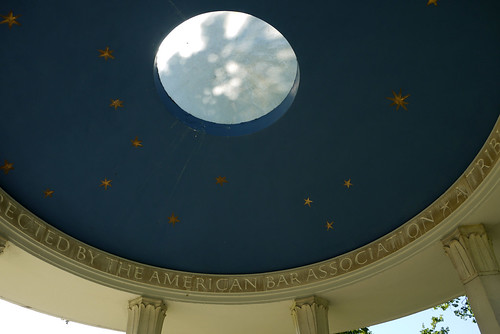Runnymede, the birthplace of democracy.
THE MAGNA CARTA TRUST
The memorial and the land on which it stands is vested in the Magna Carta Trust under the chairmanship of the Master of the Rolls. The principal object of the Magna Carta Trust is the perpetuation of the principles of Magna Carta. The Trust also maintains and cares for the up-keep of the Memorial which was commissioned by the American Bar Association.
THE AMERICAN BAR ASSOCIATION MEMORIAL TO MAGNA CARTA
The memorial was designed by Sir Edward Maufe RA and dedicated on the 28th July 1957 in ceremonies attended by over 5,000 people. Built of Portland Stone and supported on eight octagonal pillars the Memorial is a domed classical Temple in the Greek Style. In the centre is a pillar of English Granite inscribed:
‘TO COMMEMORATE MAGNA CARTA
SYMBOL OF FREEDOM UNDER LAW’
Surrounding the memorial are Eight English Oak Trees. Two further oak trees on either side of the path were planted by HRH the Duke of Gloucester in 1987 and the Prime Minister of India in 1994.
MAGNA CART THROUGHOUT THE AGES
After the third and final amendment in 1225 by King Henry III, the Magna Carta was confirmed in 1297 by King Edward I and placed on the first or ‘great’ roll of English Statute thus becoming the first constitutional document in the World. It has throughout the Ages formed a basis for law and democracy in the civilised world. Seen by every Englishman as a safeguard for their constitutional rights against unjust and arbitrary rule, the tenets of the Magna Carta have been upheld and used extensively throughout history.
During the Tudor and Stuart reigns of the 16th and 17th centuries religious intolerance and persecution was rife. By the early 1600’s Puritans no longer tolerated by the Church and Crown set off to seek a new life of religious tolerance in the new world of the American Colonies. In 1620, upon the Mayflower, the Pilgrim Fathers set sail from Plymouth taking with them a copy of the Magna Carta. The principles of the Charter granting – ‘Freedom under the Law’ – went on to form the basis for the Constitution of the United States and later the Bill of Rights, of which Thomas Jefferson said:
‘ALL MEN ARE CREATED EQUAL IN LIFE, LIBERTY
AND IN THE PURSUIT OF HAPPINESS.’
This pursuit of equality and liberty as laid down in the Magna Carta brought about the abolition of the Slave Trade by William Wilberforce and President Abraham Lincoln.
Magna Carta is still, in the twentieth century, some 780 years after its inception forming the basis for Human Rights. Its passages were quoted by Nancy Astor in the battle for votes for women during the Suffragette Movement of the early 1900’s. The principles of Magna Carta formed the basis for Human Rights during times of war under the Geneva Convention and in times of peace in the Universal Declaration of Human Rights adopted on the 10th December 1948 by the General Assembly of the United Nations. The constitutions of India and the emerging democracies of Eastern Europe have enshrined key elements and principles first established by Magna Cart.
Information about the Magna Carta Trust can be found here.












‘All men are created equal in life, liberty
and the pursuit of happiness’,
said Thomas Jefferson … of a country ‘founded by a group of slave owners who told us that all men are equal’ [George Carlin).
And how do ‘we’ resolve the issue?
Hm, you mean how to overcome evil and reach ‘enduring freedom’?
By extinguishing ‘us’.
A kind man might have a better idea to improve mankind.
Extinguishing us would also mean that we extinguish every thing that is good too.
Thanks for the little piece of history.
I am glad you found it interesting.
You’ve reminded me, Cherry, that Astrid and I were able to see the Magna Carta on display in the Salisbury Cathedral when we were there in 2015. Now I need to pinch myself!
We have seen three copies of the Magna Carta in Salisbury, Lincoln and the British Library.